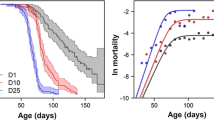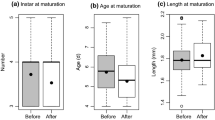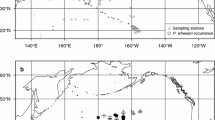Abstract
We studied the evolution of age at maturity in freshwater clams of the genus Anodonta in relation to their ecology. We analysed an age-structured density-dependent population dynamics model, which we developed for freshwater clams, using several different options for density dependence. As evolutionary optimality criteria we applied both the maximization of a fitness measure (either intrinsic rate of increase or expected lifetime fecundity) and the concept of evolutionarily stable strategies (ESSs). All three evolutionary criteria yielded estimates which were too high for the optimal age at maturity in a deterministic model with a constant survival rate. The predictions are improved when size-selective predation is included in the model. Mature clams also face a risk of infection by castrating parasites, which would select for delayed maturity. Variable newborn survival selects for earlier reproduction, though the observed levels of stochasticity probably have a negligible effect.
Similar content being viewed by others
References
Bauer, G. (1987) Reproductive strategy of freshwater pearl mussel Margaritifera margaritifera. J. Animal Ecol. 56, 691–704.
Bauer, G. (1994) The adaptive value of offspring size among freshwater mussels (Bivalvia; Unionoidea). J. Animal Ecol. 63, 933–44.
Charlesworth, B. (1994) Evolution in Age-structured Populations (2nd edn). Cambridge University Press, Cambridge.
Ferriére, R. and Clobert, J. (1992) Evolutionarily stable age at first reproduction in a density-dependent model. J. Theor. Biol. 157, 253–67.
Hanson, J.M., Mackay, W.C. and Prepas, E.E. (1988) Population size, growth, and production of a unionid clam, Anodonta grandis simpsoniana, in a small, deep boreal forest lake in central Alberta. Can. J. Zool. 66, 247–53.
Hanson, J.M., Mackay, W.C. and Prepas, E.E. (1989) Effect of size-selective predation by muskrats (Ondatra zebithicus) on a population of unionid clams (Anodonta grandis simpsoniana). J. Animal Ecol. 58, 15–28.
Haukioja, E. and Hakala, T. (1978a) Life-history evolution in Anodonta piscinalis (Mollusca, Pelecypoda). Oecologia 35, 253–66.
Haukioja, E. and Hakala, T. (1978b) Measuring growth from shell rings in populations of Anodonta piscinalis (Pelecypoda, Unionidae). Ann. Zool. Fenn. 15, 60–5.
Heino, M. and Kaitala, V. (1996) Optimal resource allocation between growth and reproduction in clams: why does indeterminate growth exist? Funct. Ecol. 10.
Jansen, W.A. and Hanson, J.M. (1991) Estimates of the number of glochidia produced by clams (Anodonta grandis simpsoniana Lea), attaching to yellow perch (Perca flavescens), and surviving to various ages in Narrow Lake, Alberta (Canada). Can. J. Zool. 69, 973–7.
Jokela, J. (1993) The selective environment of a freshwater clam: causes of selection and evolution of a life history strategy. PhD dissertation, University of Turku.
Jokela, J. and Lively, C.M. (1995) Parasites, sex and early reproduction in a mixed population of freshwater snails. Evolution 49, 1268–71.
Jokela, J. and Mutikainen, P. (1995) Effect of size-dependent muskrat (Ondatra zibethica) predation on the spatial distribution of a freshwater clam, Anodonta piscinalis Nilss. (Unionidae, Bivalvia). Can. J. Zool. 73, 1085–94.
Jokela, J., Valtonen, E.T. and Lappalainen, M. (1991) Development of glochidia of Anodonta piscinalis and their infection of fish in a small lake in northern Finland. Arch. Hydrobiol. 120, 345–55.
Jokela, J., Uotila, L. and Taskinen, J. (1993) Effect of the castrating trematode parasite Rhipidocotyle fennica on energy allocation of fresh-water clam Anodonta piscinalis. Funct. Ecol. 7, 332–8.
Kaitala, V. and Getz, W.M. (1995) Population dynamics and harvesting of semelparous species with phenotypic and genotypic variability in reproductive age. J. Math. Biol. 33, 521–56.
Kozlowski, J. and Wiegert, R.G. (1986) Optimal allocation of energy to growth and reproduction. Theor. Pop. Biol. 29, 16–37.
Lafferty, K.D. (1993) The marine snail, Cerithidea californica, matures at smaller sizes where parasitism is high. Oikos 68, 3–11.
Mangel, M. (1996) Life history invariants, age at maturity and the ferox trout. Evol. Ecol. 10, 249–263.
Maynard Smith, J. (1982) Evolution and the Theory of Games. Cambridge University Press, Cambridge.
McPhail, J.D. and Peacock, S.D. (1983) Some effects of the cestode (Schistocephalus solidus) on reproduction in the threespine stickleback (Gasterosteus aculeatus): evolutionary aspects of a host-parasite interaction. Can. J. Zool. 61, 901–8.
Minchella, D.J. and Loverde, P.T. (1981) A cost of increased early reproductive effort in the snail Biomphalaria glabrata. Am. Nat. 118, 876–81.
Mylius, S.D. and Diekmann, O. (1995) On ESS, optimization and the need to be specific about density dependence. Oikos 74, 218–224.
Negus, C.L. (1966) A quantitative study of growth and production of unionid mussels in the River Thames at Reading. J. Animal Ecol. 35, 513–32.
Payne, B.S. and Miller, A.C. (1989) Growth and survival of recent recruits to a population of Fusconaia ebena (Bivalvia: Unionidae) in the lower Ohio River. Am. Midl. Nat. 121, 99–104.
Reznick, D.N. and Endler, J.A. (1982) The impact of predation on the life history evolution in Trinidadian guppies (Poecilia reticulata). Evolution 36, 160–77.
Roff, D.A. (1983) An allocation model of growth and reproduction in fish. Can. J. Fish. Aquat. Sci. 40, 1395–404.
Roff, D.A. (1984) The evolution of life history parameters in teleosts. Can. J. Fish. Aquat. Sci. 41, 989–1000.
Stearns, S.C. and Crandall, R.E. (1981) Quantitative predictions of delayed maturity. Evolution 35, 455–63.
Taskinen, J. (1992) On the ecology of two Rhipidocotyle species (Digenea: Bucephalidae) from Finnish lakes. PhD thesis, University of Jyväskylä.
Taskinen, J. and Valtonen, E.T. (1995) Age, size, and sex-specific infection of Anodonta piscinalis (Bivalvia: Unionidae) with Rhipidocotyle fennica (Digenea: Bucephalidae) and its influence on host reproduction. Can. J. Zool. 73, 889–97.
Author information
Authors and Affiliations
Rights and permissions
About this article
Cite this article
Heino, M., Kaitala, V. Should ecological factors affect the evolution of age at maturity in freshwater clams?. Evolutionary Ecology 11, 67–81 (1997). https://doi.org/10.1023/A:1018435513099
Issue Date:
DOI: https://doi.org/10.1023/A:1018435513099




